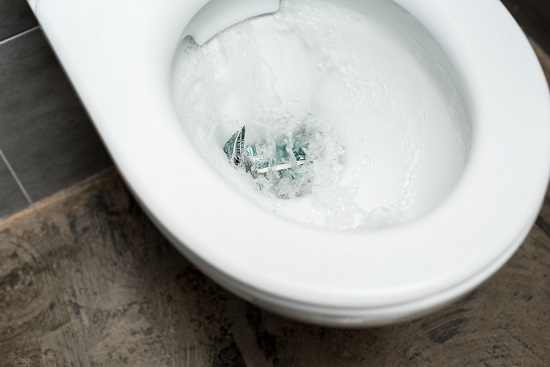
While there are many systems that can improve your comfort and convenience in your home, the most important is the functioning toilet. It can be embarrassing for guests to see your toilet when it doesn’t flush correctly, leading to partial flushes or leftover waste. An experienced DIYer can often fix a slow-flushing toilet. However, it all depends on the problem. Here are some plumbing tips you need to know.
A toilet that flushes slowly or insufficiently can have many causes. It is important to determine the root cause of the problem before it can be fixed. Low water levels, partially blocked drains, mineral buildup, defective flappers, and blocked drain vents are all common causes for slow-flushing toilets. This article will provide a detailed breakdown of the causes and possible solutions to your problem.
Plumbing Tips: Fixing some toilet problems yourself
Low water level
Low water levels are one of the main reasons toilets have trouble flushing. The tank may not have enough water to flush the toilet. This will cause the toilet’s flushing power to be reduced as there is only a small amount of force entering the toilet.
A full tank generating enough pressure to flow into the toilet bowl is sufficient to force the contents into the drain. You will likely have some waste that won’t be flushed if there isn’t enough water. Wait for the tank to refill before you flush again.
You can fix this issue by changing the level in the tank’s toilet float. The toilet float is placed on top of the water surface and turns off the fill valve when it reaches a certain level.
To increase the toilet’s flushing power, adjust the toilet float to allow more water to fill the tank before the fill valve turns off.
Partially Clogged Drain
Clogged toilets are easy to spot. Most people can use a plunger or a wrench to remove the blockage. However, a partially blocked toilet may be harder to find because it will still flush but with a significantly reduced efficacy. There are many ways to clear a partially blocked drain and restore your toilet’s flushing power.
The first thing to do is to plunge the toilet. The plunger will usually clear partial or complete clogs. However, if that fails, it is worth looking into a drain snake. If you have trouble clearing the blockage, such as with children’s toys, floss, or wipes, it’s time to call a plumber.
Mineral build-up
The jet holes on the underside and rim of the toilet bowl allow water to flow from the tank into its bowl. These holes are small and can get clogged, or partially blocked due to their small size. This reduces the flush force.
Minerals like calcium and magnesium can build up in the jet holes and block the flow of water if you live in an area with hard water.
To help remove the buildup of minerals, use distilled white vinegar and stiff-bristle toilet brushes. This will restore the toilet’s flushing power. To prevent this from happening again, it’s a good idea for you to install a water softener.
Flapper/flush valve defective
Sometimes, the problem with slow flushing toilets can be traced back at the flapper or flush valve assembly. These parts are located in the toilet tank. They release the water from the tank to the bowl. The flush valve assembly is composed of an overflow tube and a lever, chain, flapper, and the opening for the flush valve in the tank’s base.
The flapper, a rubber plug or ball that blocks access to the toilet bowl’s opening, is usually located on one side of overflow tube. The flapper is activated by pressing the button or lever on the toilet. This releases the water from the tank and lets it out into the bowl.
You can also find flush valves that are directly above the opening of your flush valve. These flush valves use a flush seat to plug the opening of the toilet bowl, instead of using a flapper. The flush valve seat lifts when the toilet is flushed. This allows the water from the tank into the bowl.
If the flapper or flush valve is damaged, the water flow into the toilet bowl could be reduced. This can cause a slower flushing toilet by reducing the flow rate. This problem can be fixed by inspecting the flush valve assembly. This can sometimes happen when the chain gets stuck or trapped. You may be able fix it fairly easily.
If the problem continues, it is possible to replace the entire flush valve assembly. It’s not a difficult repair. However, if the problem persists, you may need to contact a professional plumber in Myrtle Beach.
Ventilation of blocked drains
Many people are unaware that the plumbing drain lines that allow wastewater to flow from the home to the municipal sewer system or septic system are connected with vents. Vents are usually located on the roof. This allows gasses to escape from the pipes instead of building up and causing unpleasant odours throughout the house. They don’t only help with smell, but also release hazardous gas to the exterior.
Occupied vent lines can decrease the flushing power of toilets and should be removed immediately to avoid further problems with the wastewater system. It can be difficult to clear these vents because you have to climb up onto the roof.
This can be especially difficult if you don’t know what to look for on the roof. To clear your vents, it is a good idea to hire a professional plumber.
Like our Facebook page for more great info about plumbing services.
Call Blue Ribbon Plumbing LLC now if you need the help of a professional plumber in Myrtle Beach.
Blue Ribbon Plumbing LLC
4201 Carolina Exchange Drive Suite 202
Myrtle Beach, SC 29579
(843) 267-9733
https://www.blueribbonplumbingmb.com/
No comments:
Post a Comment